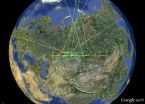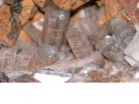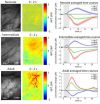(Press-News.org) Infrasonic waves from the meteor that broke up over Russia's Ural mountains last week were the largest ever recorded by the CTBTO's International Monitoring System. Infrasound is low frequency sound with a range of less than 10 Hz. The blast was detected by 17 infrasound stations in the CTBTO's network, which tracks atomic blasts across the planet. The furthest station to record the sub-audible sound was 15,000km away in Antarctica.
The origin of the low frequency sound waves from the blast was estimated at 03:22 GMT on 15 February 2013. People cannot hear the low frequency waves that were emitted but they were recorded by the CTBTO's network of sensors as they travelled across continents.
"We saw straight away that the event would be huge, in the same order as the Sulawesi event from 2009. The observations are some of the largest that CTBTO's infrasound stations have detected," CTBTO acoustic scientist, Pierrick Mialle said.
Until last week, the bolide explosion above Sulawesi, Indonesia, in October 2009 was the largest infrasound event registered by 15 stations in the CTBTO's network.
Infrasound has been used as part of the CTBTO's tools to detect atomic blasts since April 2001 when the first station came online in Germany. Data from the stations is sent in near real time to Vienna, Austria, for analysis at the CTBTO's headquarters. Both the raw and analysed data are provided to all Member States.
"We know it's not a fixed explosion because we can see the change in direction as the meteorite moves towards the earth. It's not a single explosion, it's burning, traveling faster than the speed of sound. That's how we distinguish it from mining blasts or volcanic eruptions.
"Scientists all around the world will be using the CTBTO's data in the next months and year to come, to better understand this phenomena and to learn more about the altitude, energy released and how the meteor broke up," Mialle said.
VIDEO:
Infrasonic waves from the meteor that broke up over Russia's Ural mountains on 15 Feb. 2013 were the largest ever recorded by the CTBTO's International Monitoring System. Watch this animation...
Click here for more information.
The infrasound station at Qaanaaq, Greenland was among those that recorded the meteor explosion in Russia. There are currently 45 infrasound stations in the CTBTO's network that measure micropressure changes in the atmosphere generated by infrasonic waves. Like meteor blasts, atomic explosions produce their own distinctive, low frequency sound waves that can travel across continents.
Infrasound is one of four technologies (including seismic, hydroacoustic and radionuclide) the CTBTO uses to monitor the globe for violations of the Comprehensive Nuclear-Test-Ban Treaty that bans all nuclear explosions.
Seismic signals from the meteor were also detected at several Kazakh stations close to the explosion and impact area. In the accompanying video file, you can listen to the audio files of the infrasound recording after it has been filtered and the signal accelerated.
Days before the meteor on 12 February 2013, the CTBTO's seismic network detected an unusual seismic event in the Democratic People's Republic of Korea (DPRK), which measured 4.9 in magnitude. Later that morning, the DPRK announced that it had conducted a nuclear test. The event was registered by 94 seismic stations and two infrasound stations in the CTBTO's network. The data processing and analysis are designed to weed out natural events and focus on those events that might be explosions, including nuclear explosions.
INFORMATION:
For further information on the CTBT, please see www.ctbto.org – your resource on ending nuclear testing, or contact:
Annika Thunborg
Spokesperson and Chief
Public Information
T 43-1-26030-6375
E annika.thunborg@ctbto.org
M 43-699-1459-6375
I www.ctbto.org
Russian fireball largest ever detected by CTBTO's infrasound sensors
2013-02-19
ELSE PRESS RELEASES FROM THIS DATE:
Researchers create semiconductor 'nano-shish-kebabs' with potential for 3-D technologies
2013-02-19
Researchers at North Carolina State University have developed a new type of nanoscale structure that resembles a "nano-shish-kebab," consisting of multiple two-dimensional nanosheets that appear to be impaled upon a one-dimensional nanowire. But looks can be deceiving, as the nanowire and nanosheets are actually a single, three-dimensional structure consisting of a single, seamless series of germanium sulfide (GeS) crystals. The structure holds promise for use in the creation of new, three-dimensional (3-D) technologies.
The researchers believe this is the first engineered ...
Theory of crystal formation complete again
2013-02-19
Exactly how a crystal forms from solution is a problem that has occupied scientists for decades. Researchers at Eindhoven University of Technology (TU/e), together with researchers from Germany and the USA, are now presenting the missing piece. This classical theory of crystal formation, which occurs widely in nature and in the chemical industry, was under fire for some years, but is saved now. The team made this breakthrough by detailed study of the crystallization of the mineral calcium phosphate –the major component of our bones. The team published their findings yesterday ...
New study shows how seals sleep with only half their brain at a time
2013-02-19
TORONTO, ON – A new study led by an international team of biologists has identified some of the brain chemicals that allow seals to sleep with half of their brain at a time.
The study was published this month in the Journal of Neuroscience and was headed by scientists at UCLA and the University of Toronto. It identified the chemical cues that allow the seal brain to remain half awake and asleep. Findings from this study may explain the biological mechanisms that enable the brain to remain alert during waking hours and go off-line during sleep.
"Seals do something biologically ...
We know when we're being lazy thinkers
2013-02-19
Are we intellectually lazy? Yes we are, but we do know when we take the easy way out, according to a new study by Wim De Neys and colleagues, from the CNRS in France. Contrary to what psychologists believe, we are aware that we occasionally answer easier questions rather than the more complex ones we were asked, and we are also less confident about our answers when we do. The work is published online in Springer's journal Psychonomic Bulletin & Review.
Research to date on human thinking suggests that our judgment is often biased because we are intellectually lazy, or ...
NYU's Shedlin publishes study on the health of Colombian refugees in Ecuador
2013-02-19
New York University College of Nursing's Professor Michele Shedlin, PhD, recently published a paper, "Sending-Country Violence and Receiving-Country Discrimination: Effects on the Health of Colombian Refugees in Ecuador," on-line in the Journal of Immigrant and Minority Health, February 2, 2013.
Studies of immigrant health have historically focused on individual-level risk factors more than environmental/structural factors as salient mediating variables. Shedlin's research addresses the need to reach a more complete understanding of the migration process and vulnerabilities ...
Study shows that diet of resistant starch helps the body resist colorectal cancer
2013-02-19
As the name suggests, you can't digest resistant starch so it ends up in the bowel in pretty much the same form it entered your mouth. As unlovely as that seems, once in the bowel this resistant starch does some important things, including decreasing bowel pH and transit time, and increasing the production of short-chain fatty acids. These effects promote the growth of good bugs while keeping bad bugs at bay. A University of Colorado Cancer Center review published in this month's issue of the journal Current Opinion in Gastroenterology shows that resistant starch also helps ...
Annals of Internal Medicine tip sheet for Feb. 19, 2013
2013-02-19
1. Acupuncture May be an Effective Alternative for Treating Seasonal Allergies
Patients receiving acupuncture treatments for seasonal allergic rhinitis reported statistically significant improvements in symptoms and decreased use of medication compared to patients having standard treatment or sham acupuncture, but the clinical significance of the observed improvements is uncertain. Allergic rhinitis (stuffy or runny nose caused by allergies) is an extremely common condition that affects approximately 20 percent of the U.S. population. Despite the availability of effective ...
Shedding new light on infant brain development
2013-02-19
New York, NY—February 18, 2013—A new study by Columbia Engineering researchers finds that the infant brain does not control its blood flow in the same way as the adult brain. The paper, which the scientists say could change the way researchers study brain development in infants and children, is published in the February 18 Early Online edition of Proceedings of the National Academy of Sciences (PNAS).
"The control of blood flow in the brain is very important" says Elizabeth Hillman, associate professor of Biomedical Engineering and of Radiology, who led the research study ...
The role of goop: Research shows pollution doesn't change the rate of droplet formation
2013-02-19
When it comes to forming the droplets that make up clouds, a little oily and viscous organic material apparently doesn't matter that much. And that's good news for reducing the uncertainty of climate model predictions.
Understanding cloud formation is essential for accurate climate modeling, and understanding cloud formation begins with the droplets that make up clouds. Droplets form when water vapor is attracted to particles floating in the atmosphere. These particles include dust, sea salt from the ocean, microorganisms, soot, sulfur – and organic material that can ...
Study suggests women have higher risk of hip implant failure
2013-02-19
Women appear to have a higher risk of implant failure than men following total hip replacement after considering patient-, surgery-, surgeon-, volume- and implant-specific risk factors, according to a report published Online First by JAMA Internal Medicine, a JAMA Network publication.
Total hip replacement, also known as total hip arthroplasty (THA), is more often performed in women than men. Sex-specific risk factors and outcomes have been investigated in other major surgical procedures and, in theory, might be more important to study in THA because of anatomical differences ...


